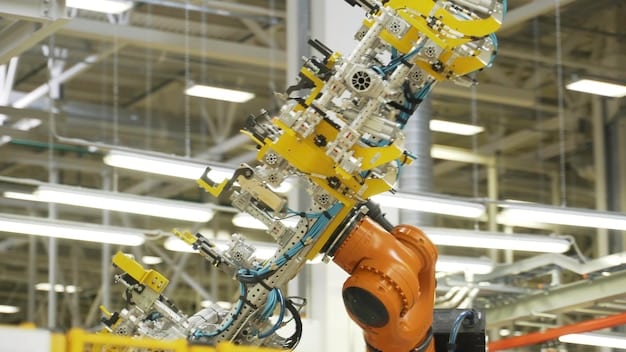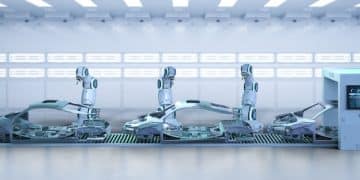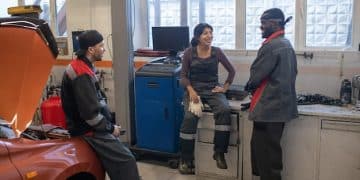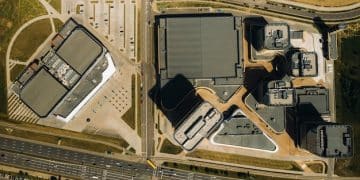Automotive Workforce Changes: EV Shift Impact on Jobs

The shift towards electric vehicles (EVs) is projected to significantly alter the automotive workforce, leading to new job creation in areas like software development and battery technology, while traditional manufacturing roles face potential displacement.
The automotive industry is undergoing a monumental transformation, driven by the increasing adoption of electric vehicles (EVs). This shift is not just about changing what powers our cars; it’s also reshaping the very fabric of the automotive workforce. The question on everyone’s mind is: What are the Projected Changes in the Automotive Workforce Due to the Shift Towards Electric Vehicles? Let’s dive in and explore the evolving landscape.
How Electric Vehicles are Reshaping the Automotive Industry
The rise of electric vehicles is more than just a trend; it’s a full-blown revolution in the automotive industry. This transformation is impacting everything from manufacturing processes to the skill sets required in the workforce. The shift is driven by environmental concerns, stricter regulations, and increasing consumer demand for greener transportation options.
Understanding this shift is crucial for both employers and employees in the automotive sector. Companies need to adapt their training programs and hiring strategies to meet the demands of the EV market, while workers need to acquire new skills to remain relevant in a rapidly changing industry.
The Growing Demand for Electric Vehicles
Consumer interest in EVs is soaring, thanks to advancements in battery technology, increased driving range, and the availability of more affordable models. Governments around the world are also incentivizing EV adoption through tax credits and subsidies.
Impact on Traditional Automotive Roles
While the shift to EVs is creating new opportunities, it’s also disrupting traditional automotive roles. Jobs related to internal combustion engines (ICE) are likely to decline as EVs gain market share. This necessitates a significant retraining and upskilling effort to help workers transition to new roles in the EV sector.

In conclusion, the automotive industry is in a state of flux, with electric vehicles at the forefront of innovation. Understanding the drivers behind this shift and its impact on the workforce is essential for navigating the challenges and opportunities that lie ahead.
New Skills and Roles Emerging in the EV Sector
As the automotive industry electrifies, a whole new set of skills and roles are coming into demand. These roles span across various areas, including software engineering, battery technology, and charging infrastructure. Professionals with expertise in these domains are becoming increasingly valuable.
Let’s explore some of the key new skills and roles emerging in the EV sector:
- Software Engineers: EVs rely heavily on software for everything from battery management to autonomous driving features. Skilled software engineers are needed to develop and maintain these complex systems.
- Battery Technicians: Battery technology is at the heart of EVs. Technicians specializing in battery manufacturing, testing, and recycling are in high demand.
- Charging Infrastructure Specialists: As the EV market grows, so does the need for charging infrastructure. Specialists are needed to design, install, and maintain charging stations.
The Importance of Upskilling and Retraining Programs
To successfully transition to the EV sector, workers need access to comprehensive upskilling and retraining programs. These programs should focus on providing hands-on training in areas like EV repair, battery technology, and software development.
Collaboration Between Industry and Educational Institutions
A collaborative effort between industry and educational institutions is essential to ensure that training programs are aligned with the needs of the EV market. Companies can work with schools to develop specialized courses and provide internships for students.
In summary, the EV sector is creating a wealth of new opportunities for workers with the right skills. Upskilling and retraining programs, along with industry-education collaboration, are critical for preparing the workforce for the electric future.
The Impact on Manufacturing and Assembly Line Jobs
The shift to electric vehicles is having a profound impact on manufacturing and assembly line jobs. EVs have fewer moving parts than traditional ICE vehicles, which means that the manufacturing process is simpler and requires fewer workers in certain areas. This is leading to a shift in the skills required for these roles.
The reduction in complexity is primarily due to the fewer number of components in an EV powertrain compared to an ICE. An EV powertrain typically consists of a battery pack, electric motor, and inverter, while an ICE includes hundreds of parts such as pistons, valves, and a complex exhaust system. This simplification changes the nature of manufacturing jobs.

- Automation: EV manufacturing is increasingly automated, with robots performing tasks that were previously done by human workers.
- New Materials: EVs use different materials than ICE vehicles, such as lightweight composites and specialized battery components. Workers need to be trained in handling these new materials.
- Quality Control: With fewer moving parts, quality control in EV manufacturing focuses on different aspects, such as battery performance and software integration.
The Role of Human Workers in Automated Factories
While automation is increasing, human workers still play a crucial role in EV manufacturing. They are needed to oversee automated systems, perform complex assembly tasks, and ensure quality control.
Creating Safer and More Efficient Workplaces
EV manufacturing offers the opportunity to create safer and more efficient workplaces. Automation can reduce the risk of injuries, while streamlined processes can improve productivity.
In conclusion, the shift to electric vehicles is reshaping manufacturing and assembly line jobs. Automation, new materials, and a focus on quality control are key trends in EV manufacturing. Human workers will continue to play a vital role, but their skills will need to evolve to meet the demands of the electric future.
Geographic Shifts in Automotive Employment
The transition to electric vehicles is not just changing the types of jobs available in the automotive industry; it’s also causing geographic shifts in employment. Traditional automotive hubs may see a decline in jobs related to ICE vehicles, while new centers of EV production and technology are emerging.
Several factors contribute to these geographic shifts. Proximity to battery manufacturing facilities, access to skilled labor in software and electronics, and government incentives all play a role in attracting EV-related investments. As a result, some regions are experiencing rapid growth in EV employment, while others are struggling to adapt.
The Rise of New Automotive Hubs
States like California, Nevada, and Michigan are becoming major centers for EV research, development, and manufacturing. These states offer a combination of skilled labor, favorable regulations, and access to venture capital.
The Impact on Traditional Automotive Centers
States like Ohio, Indiana, and Kentucky, which have historically been centers for ICE vehicle production, may face challenges as the industry shifts to EVs. These states need to invest in retraining programs and attract new EV-related businesses to remain competitive.
In summary, the automotive industry is undergoing significant geographic shifts as it transitions to electric vehicles. New automotive hubs are emerging, while traditional centers need to adapt to the changing landscape. Government policies, industry investments, and workforce development initiatives will play a crucial role in shaping the future of automotive employment.
Government Policies and Their Influence on the Workforce
Government policies play a critical role in shaping the automotive workforce during the transition to electric vehicles. Incentives for EV adoption, investments in charging infrastructure, and regulations on emissions all have a direct impact on job creation and skill requirements. Understanding these policies is essential for both employers and employees in the automotive sector.
Government policies can incentivize the purchase of EVs through tax credits, rebates, and subsidies. These incentives increase consumer demand, which in turn drives investment in EV manufacturing and creates jobs. Additionally, investments in charging infrastructure make it easier for consumers to switch to EVs, further boosting demand.
- Tax Credits and Subsidies: Government incentives can make EVs more affordable, increasing demand and driving job creation.
- Charging Infrastructure Investments: Investments in charging stations support EV adoption and create jobs in installation and maintenance.
- Emissions Regulations: Stricter emissions regulations encourage automakers to invest in EVs, leading to new job opportunities.
The Role of Regulations in Shaping the Automotive Industry
Regulations on emissions and fuel efficiency can push automakers to invest in EVs and other alternative fuel vehicles. These regulations create a demand for engineers, technicians, and other professionals with expertise in EV technology.
Promoting Green Jobs and Sustainable Transportation
Government policies can promote green jobs and sustainable transportation by providing incentives for companies that invest in EV manufacturing and research. These policies can create a pathway to a cleaner and more sustainable automotive industry.
In conclusion, government policies have a significant influence on the automotive workforce during the transition to electric vehicles. Incentives for EV adoption, investments in charging infrastructure, and regulations on emissions can all drive job creation and shape the skills required in the industry.
Strategies for Adapting to the EV Shift: A Guide for Workers and Companies
The shift to electric vehicles presents both challenges and opportunities for workers and companies in the automotive industry. To thrive in this evolving landscape, it’s essential to adopt proactive strategies for adapting to the changes. This includes upskilling and retraining for workers, and strategic investments and workforce development for companies.
For workers, the key is to acquire new skills that are in demand in the EV sector. This can involve taking courses in EV repair, battery technology, or software development. It’s also important to stay informed about the latest trends and technologies in the industry. For companies, the focus should be on strategic investments in EV technology and workforce development programs.
Upskilling and Retraining for Workers
Workers should take advantage of upskilling and retraining programs to acquire new skills in areas like EV repair, battery technology, and software development. These programs can help them transition to new roles in the EV sector.
Investing in Workforce Development Programs
Companies should invest in workforce development programs to ensure that their employees have the skills needed to succeed in the EV market. These programs can include on-the-job training, apprenticeships, and partnerships with educational institutions.
In summary, adapting to the EV shift requires a proactive approach from both workers and companies. Upskilling and retraining, strategic investments, and workforce development programs are essential for navigating the challenges and opportunities that lie ahead.
| Key Point | Brief Description |
|---|---|
| 💡 Software Roles | Increased demand for software engineers in EV development and maintenance. |
| 🔋 Battery Tech | Growing need for battery technicians in manufacturing, testing, and recycling. |
| ⚙️ Manufacturing Shifts | Automation and new materials are changing manufacturing and assembly line jobs. |
| 🌎 Geographic Changes | Emergence of new automotive hubs and challenges for traditional centers. |
FAQ
▼
New roles include software engineers focused on battery management, battery technicians for manufacturing and recycling, and charging infrastructure specialists for installation and maintenance.
▼
EV manufacturing involves fewer moving parts, increased automation, and the use of new materials like lightweight composites. This requires different skills and processes on the assembly line.
▼
Workers should pursue upskilling and retraining programs in areas like EV repair, battery technology, and software development to stay relevant in the changing automotive industry.
▼
Governments influence the EV transition through incentives for EV adoption, investments in charging infrastructure, and regulations on emissions, all of which impact job creation.
▼
Traditional automotive hubs may face challenges, while new centers of EV production and technology are emerging, leading to shifts in automotive employment across different regions.
Conclusion
The automotive workforce is undergoing a significant transformation due to the shift towards electric vehicles. While some traditional roles may decline, new opportunities are emerging in areas like software development, battery technology, and charging infrastructure. By embracing upskilling initiatives and strategic investments, both workers and companies can successfully navigate this evolving landscape and thrive in the electric future.





